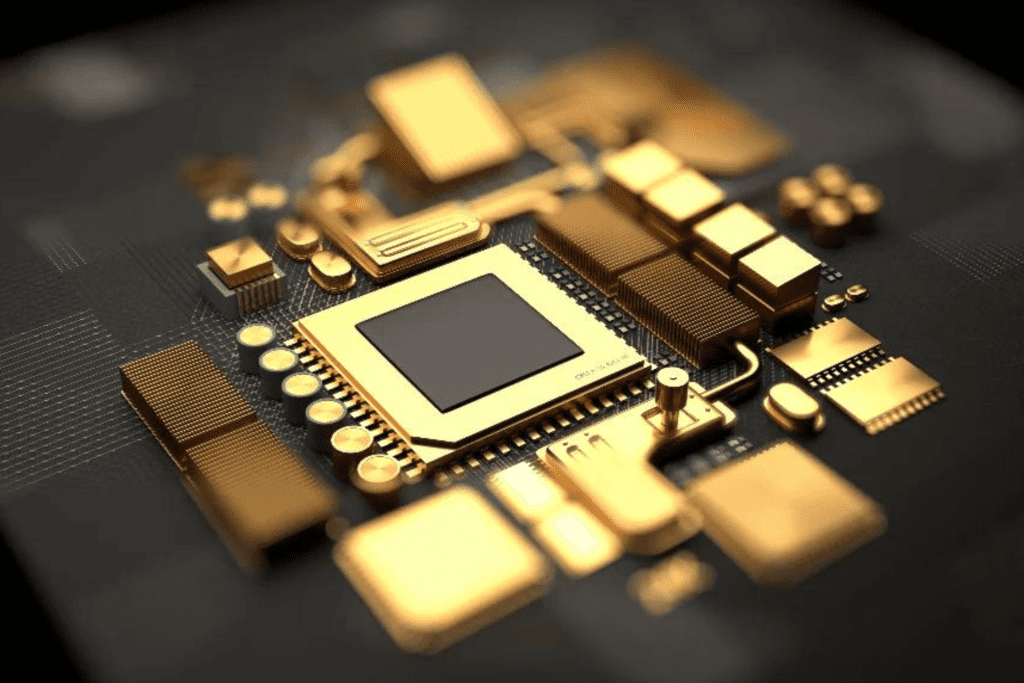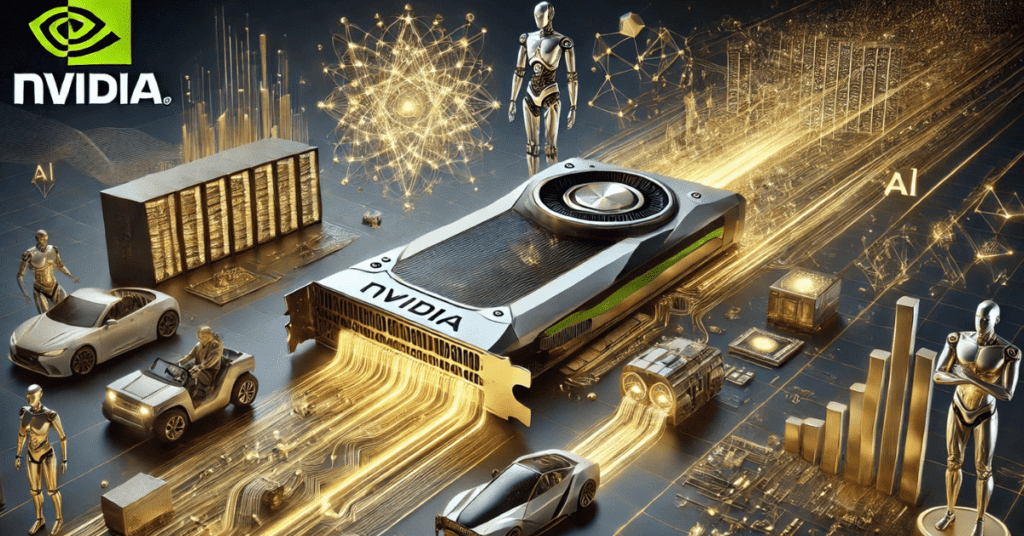Introduction: NVIDIA’s GPUs Midas Touch in the Tech World
Did you know that gold, the timeless symbol of wealth, is the cutting-edge unsung hero behind NVIDIA’s GPUs? As a gold enthusiast with a passion for technology, I’m thrilled to take you on a journey exploring how this precious metal is powering the future of computing. You might be wondering, “How can a traditional precious metal be so crucial in modern tech?” Well, prepare to be amazed as we uncover the golden secrets propelling NVIDIA to the forefront of the AI revolution.
NVIDIA has long been synonymous with groundbreaking graphics processing units (GPUs) and artificial intelligence (AI) innovations. But beneath the surface of these technological marvels lies an element as old as civilization itself: gold. This precious metal isn’t just for jewelry or investment; it’s the hidden powerhouse driving NVIDIA’s dominance in the GPU and AI chip market.
Imagine gold as the secret ingredient in NVIDIA’s recipe for success. Just as a pinch of salt can elevate a dish, the strategic use of gold elevates NVIDIA’s products to unprecedented heights of performance and reliability. But how exactly does NVIDIA harness the power of this ancient metal to stay at the cutting edge of technology? Let’s dig deeper into this golden mystery.
Why Gold? The Midas Metal in Modern Tech

You might be thinking, “Surely there are cheaper alternatives to gold in technology?” While that’s a valid question, gold offers a unique combination of properties that make it irreplaceable in high-precision devices like GPUs. Let’s break down these golden attributes:
Electrical Conductivity: The Information Superhighway
Think of gold as the ultimate highway for electricity. Just as a smooth, wide highway allows cars to flow freely without traffic jams, gold’s excellent conductivity enables electrical signals to travel efficiently with minimal resistance. This property is crucial for the lightning-fast data processing required in modern GPUs, especially when tackling complex tasks like deep learning and AI computations.
Corrosion Resistance: The Timeless Performer
Imagine if the wires in your computer started to rust or tarnish. It would be a disaster, right? That’s where gold’s corrosion resistance comes into play. Unlike many other metals, gold doesn’t corrode or tarnish, ensuring that NVIDIA’s GPUs maintain their peak performance over time, even in challenging environments. It’s like having a car that never rusts, always ready for top performance.
Malleability and Ductility: The Microscopic Sculptor’s Dream
Picture gold as the world’s most cooperative modeling clay. Its ability to be shaped into incredibly thin wires or sheets without breaking is a game-changer in the world of microchips. This malleability allows NVIDIA to create intricate circuitry within the compact space of a GPU, much like a skilled artist creating a masterpiece on a tiny canvas. This property is crucial for maximizing performance while minimizing size in our increasingly compact devices.
Reliability: The Steadfast Guardian of Performance
In the high-stakes world of AI and data processing, reliability is paramount. Gold’s stable properties make it the steadfast guardian of electronic component performance. When you’re running complex AI models or rendering high-fidelity graphics, gold ensures that your GPU performs consistently, without glitches or failures. It’s like having a trusty sidekick that never lets you down, no matter how challenging the task.
Gold in NVIDIA’s GPUs: Where the Magic Happens

Now that we understand why gold is so valuable in technology let’s zoom in on its role in NVIDIA’s GPUs. Where exactly can we find this precious metal within these powerful computing machines?
Gold primarily resides in the microchips and internal computer wiring of NVIDIA’s GPUs. Imagine these gold connections as the nervous system of the GPU, ensuring seamless data transmission between various components. This intricate network of golden pathways contributes significantly to the GPU’s overall performance and reliability.
But gold isn’t working alone in this technological marvel. It’s part of a team of metals, including tantalum, tungsten, and tin, each playing a crucial role in NVIDIA’s GPUs functionality. Together, these metals form the backbone of NVIDIA’s cutting-edge GPU architectures like Turing, Ampere, Ada Lovelace, and the upcoming Blackwell.
NVIDIA’s Golden Rule: Commitment to Ethical Sourcing
In today’s world, it’s not just about using gold; it’s about using it responsibly. NVIDIA has made a strong commitment to using “conflict-free” gold in its products. But what does this mean, and why is it so important?
Ethical sourcing ensures that the gold used in NVIDIA’s products is obtained from legitimate, conflict-free sources. This commitment is crucial in the tech industry, where the demand for precious metals can sometimes fuel conflicts and human rights abuses in mining regions.
NVIDIA’s stance on ethical sourcing goes beyond mere compliance; it sets a gold standard for the entire industry. By prioritizing responsible mining practices, NVIDIA not only ensures the ethical integrity of its supply chain but also builds trust with consumers who want their high-performance GPUs to come with a clear conscience.
This commitment to ethical sourcing has broader implications:
1. It encourages other tech companies to follow suit, creating a ripple effect across the industry.
2. It supports sustainable mining practices, benefiting local communities and the environment.
3. It aligns with the growing consumer demand for ethically produced technology products.
By adhering to this golden rule, NVIDIA is not just creating powerful GPUs; it’s contributing to a more responsible and sustainable tech ecosystem.
Striking Gold: NVIDIA’s Financial and Technological Growth
NVIDIA’s commitment to innovation and quality has certainly paid off, with the company recently reporting a record quarterly revenue of $30 billion. But how did they transform from a graphics card manufacturer to a tech industry titan?
One key milestone in NVIDIA’s journey was the acquisition of 3dfx in 2002. This strategic move significantly boosted NVIDIA’s technological capabilities, setting the stage for its dominance in the GPU market. It’s like NVIDIA found a golden key that unlocked new realms of technological possibilities.
But NVIDIA didn’t stop there. The company has consistently pushed the boundaries of what’s possible with NVIDIA’s GPUs, evolving from primarily serving the gaming market to becoming a powerhouse in AI and deep learning. This journey is akin to an alchemist transforming not just lead into gold, but gold into something even more valuable: cutting-edge AI technology.
The Midas Touch: NVIDIA’s Technological Innovations and AI Leadership
NVIDIA’s GPU architectures have been at the forefront of technological innovation, each generation bringing new capabilities and performance improvements. Let’s take a quick tour through some of their groundbreaking designs:
Turing Architecture: The AI Artist
Named after the father of computer science, Alan Turing, this architecture introduced real-time ray tracing and AI-enhanced graphics. Imagine it as a digital painter, capable of creating stunningly realistic images in real-time, revolutionizing the gaming and visual effects industries.
Ampere Architecture: The Deep Learning Dynamo
Ampere took AI capabilities to new heights, offering unprecedented performance for data centers and AI tasks. It’s like giving a supercomputer a turbo boost, enabling it to tackle complex AI problems with ease.
Ada Lovelace Architecture: The Efficiency Expert
Named after the world’s first computer programmer, this architecture focuses on energy efficiency without compromising on performance. Think of it as a hybrid car for computing – powerful yet environmentally conscious.
Blackwell Architecture: The Future of AI
Still in development, Blackwell promises to push the boundaries of AI even further, potentially supporting trillion-parameter AI models. It’s like giving AI a crystal ball, enabling it to make more accurate predictions and solve even more complex problems.
These architectures have cemented NVIDIA’s role as a leader in AI and deep learning. Their GPUs are now the go-to choice for data centers and AI researchers worldwide, powering everything from autonomous vehicles to groundbreaking medical research.
The Golden Age of AI: NVIDIA’s Future Prospects

So, what’s next for NVIDIA? The company is heavily investing in next-generation AI platforms and technologies. The introduction of the Blackwell platform, in particular, has the potential to revolutionize AI by supporting models with trillions of parameters.
This focus on AI isn’t just about staying competitive; it’s about shaping the future of technology. As AI continues to permeate every aspect of our lives, from smartphones to smart cities, NVIDIA’s gold-enhanced GPUs will likely play an increasingly crucial role.
Imagine a future where AI assists in solving some of humanity’s most pressing challenges – from climate change to disease prevention. NVIDIA’s technologies could be at the heart of these solutions, powered by the golden connections within their GPUs.
Conclusion: NVIDIA’s Golden Legacy in Tech
As we’ve uncovered, gold is more than just a precious metal in NVIDIA’s world – it’s a crucial component that enables their technological marvels. From the intricate wiring in NVIDIA’s GPUs to their commitment to ethical sourcing, gold is intertwined with NVIDIA’s past, present, and future.
NVIDIA’s ongoing innovation and leadership in the tech industry truly set the gold standard for what’s possible in high-performance computing and AI. They’ve shown that by combining the timeless properties of gold with cutting-edge technology, we can unlock new realms of possibility.
As we look to the future, one thing is clear: in the world of high-performance computing and AI, NVIDIA continues to have the Midas touch. Their golden innovations are not just shaping the tech industry; they’re paving the way for advancements that could benefit all of humanity.
So, the next time you marvel at the graphics in your favorite game, experience the magic of AI, or hear about a breakthrough in scientific computing, remember – there’s a bit of gold making that magic happen. And chances are, NVIDIA’s golden heart is beating at the center of it all.
Based on your detailed article, here is an optimized FAQ section to reinforce the content:
FAQs: Gold in NVIDIA’s GPUs
1. Why is gold used in NVIDIA’s GPUs?
Gold is used in NVIDIA’s GPUs due to its exceptional electrical conductivity, resistance to corrosion, and malleability. These properties make it ideal for ensuring efficient data transmission and long-term reliability in high-performance components like GPUs.
2. Where exactly is gold used in NVIDIA’s GPUs?
Gold is found in the microchips and internal wiring of NVIDIA’s GPUs, forming critical connections that facilitate seamless data transmission and optimize performance.
3. Can cheaper alternatives replace gold in GPUs?
While alternatives like copper exist, gold remains irreplaceable in certain applications due to its unique combination of conductivity, corrosion resistance, and ease of use in microscopic circuit designs.
4. How does NVIDIA ensure ethical sourcing of gold?
NVIDIA prioritizes “conflict-free” gold, sourced responsibly to avoid contributing to conflicts or human rights abuses. This commitment aligns with global standards and supports sustainable mining practices.
5. How much gold is typically found in a GPU?
The amount of gold in a single GPU is minimal, often measured in micrograms, as only thin layers are required for electrical connections. However, the cumulative use of gold across GPUs and other electronics is significant.
6. What other metals are used in NVIDIA’s GPUs alongside gold?
In addition to gold, NVIDIA’s GPUs utilize metals like tantalum, tungsten, and tin, which contribute to their advanced functionality and durability.
7. What makes NVIDIA’s use of gold unique compared to other tech companies?
NVIDIA combines gold with innovative GPU architectures like Turing, Ampere, Ada Lovelace, and Blackwell, optimizing performance for applications ranging from gaming to AI and deep learning.
8. Does gold impact the cost of NVIDIA’s GPUs?
Gold’s cost is a factor but is outweighed by its contribution to the reliability and performance of NVIDIA’s GPUs. The benefits of using gold in critical components justify its inclusion.
9. How does gold enhance the reliability of NVIDIA GPUs?
Gold’s resistance to corrosion ensures stable performance over time, even in demanding environments, making it a cornerstone for high-reliability GPUs.
10. What role does NVIDIA’s GPUs play in AI development?
NVIDIA’s GPUs, powered by gold-enhanced technology, drive advancements in AI by supporting complex models, real-time data processing, and cutting-edge deep learning capabilities.







